Bass Fishing Ledges | How To Find & Fish Ledges For Bass
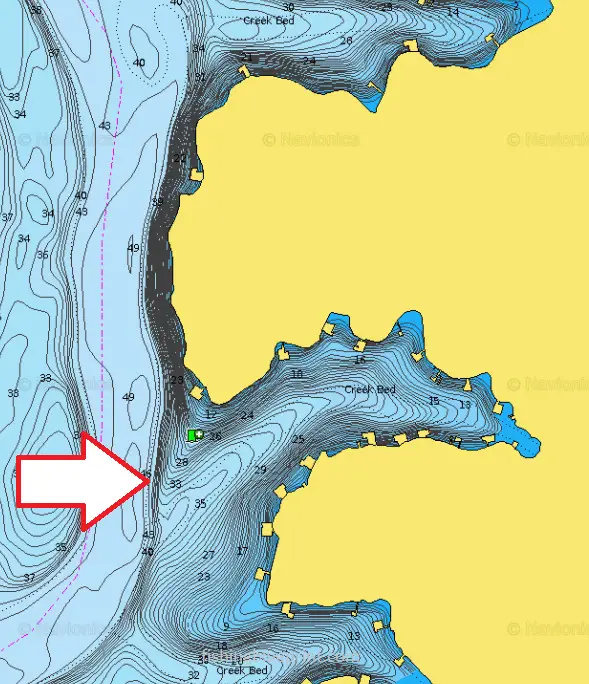
Are you finding it hard to fishing ledges for bass? Bass fishing ledges is luckily relatively easy to get into. It is not a technique that has a high barrier to entry and it does not requires a ton of new gear to purchase. But it does take some time to learn… and… I’m sure you’ve seen other anglers pull out sacks of giant bass fishing ledges!
But, there is one indisputable piece of evidence that is true. Ledge fishing is both a science and an art form. But over the years I’ve developed a 7-step blueprint that helps me stay centered whenever I want to fish a ledge. It contains invaluable insights which I now totally embrace.
Key Takeaways
These techniques have become second nature to me now, they are the thoughts and strategies that automatically pop up anytime I need to fish offshore or on the ledge. Here are just some of the things you’ll learn in this ledge fishing blueprint:
- What question and serious angler (like yourself) must ask when you get to the lake to start catching fish as fast as humanly possible!
- How your PC can get you extra bites when you’re on the water!
- The single best way ever discover and find the perfect ledge… and… catch fish fast!
- How you can legally check to see if bass are actually on the ledge (not some other fish like crappie)… you will get your answer in less than 1 minute… and helps you avoid spending countless hours on the wrong fishing spot!
- Learn the one-two punch for making inactive or suspended bass bite – even Mike Tyson would be proud!
If you ever got suckered into fishing the wrong ledge, you know it can be similar to being in a barren ghost town, wasting hours of your day, or forced to deal with a painful arm, or worse!
In our fishing blueprint, helps you avoid all that… lets get started…
But be warned! Go through the this blueprint slowly and carefully so you don’t miss any tips that could cost you.
Ledge Fishing Primer | What Is a Ledge Pertaining to Bass Fishing?
If you already know what a ledge is just skip to the next section below, but if you don’t keep reading…
Ledge fishing is one of the oldest types of bass fishing techniques, used by many generations of anglers to catch smallmouth, spotted, and largemouth bass.
Unfortunately, thousands of anglers have tried fishing ledges, only to move to a completely different type of spot.
Why? Because fishing a ledge the right way is a closely guarded secret.
A ledge is a steep slope or drop off in depth from a higher flat surface in the lake. It is located where deeper water and shallow water levels abruptly meet.
It’s most commonly the edge of a creek channel or main river channel.
Helpful Tip: Ledges can be at any depth before they drop off to a deeper area at the bottom of the lake.
The slope going down is the “side of the ledge”, and the “top of the ledge” is the top of the shallow end in this example.
Bass often move from shallow to deeper water after spawning so they can rest and then find prey. They may stay suspended above the top of the ledge or on the ledge side.
Once rested, the bass may also use the ledge as a “highway” and travel up and down the ledge finding other hunting grounds, or sometimes they stay put and feed if the area itself is a good hunting ground.
Some lakes have many ledges that are miles long, while others have short confined ledges. But depending on the layout of the lake, not all ledges are filled with bass.
Bass fishing on ledges is a very popular location for anglers to fish bass. It can be discouraging if you don’t know where the bass are sitting and hiding.
Fishing random locations on a ledge is not the recommended way to catch big bass.
Why Fish a Ledge for Bass?
About half of the bass in any given lake travel to deeper water after spawning. They are very hungry and are usually willing to bite any interesting bait that is in front of them.
Experienced anglers know that ledges are a common place for bass to hide during this time in late spring and summer. This is usually between May/June (in warmer parts of the U.S.) and July/August (in colder parts of the U.S.).
Fishing bass on a ledge can be very rewarding. Some anglers find areas where they catch one lunker after another from a school of bass.
The trick is finding a sweet spot, marking it with buoys or noting landmarks where this spot is located. Throwing in this same area after one successful catch is often productive.
Step 1: Find the Ledge in a Lake or River On Your Map – What Structural Features Do You Need to Look For?
Ledges can be found with either a physical topographic map, or a topographic map on a fish finder.
First, take a look at the contour lines on the topographic map.
You’ll notice some lines are close together and some lines are more spread apart.
When the lines on your map are close together, this shows the depth in the water dropping or rising. Numerical depth indicators on the lines will tell you the actual depth. Contour lines that are spread apart indicate a flatter area.
Then, when you observe an area that’s shallow and flat, then has an abrupt drop in depth over a wider distance that is considered a ledge on your map.
As stated before the most common ledge you’ll find is going to be the edge of a creek channel or river channel. And on your map it will appear in the shape of a curved line, an “S” or sometimes will be semi-straight.
The main river channel is the location of where the original river was before the area was impounded and will run the entire length of the lake.
A creek channel will start at the top of a cove and make its way to the main lake or river.
A ditch is a small secondary channel and will drain most commonly into a cove or even the main lake or river.
Here is an example of Lake Travis. How many ledges can you find?


Visual Shoreline Clues…
By looking at the shoreline it can give you clues to where the creek channel is located.
And inside bends in a channel often denote a channel swing and there will be a ledge very close by.
You may first see the surrounding banks being gentle sloping and gradually get steeper and rockier. Chances are this is a channel swing and there will be a ledge nearby.
Helpful Tip: One great tip is to use Google Earth on your PC at home to find ledges when the water is drawn down on your lake. Then you’ll also quickly and easily find any rock piles, ridges, maybe even a large brush pile that someone dropped into the lake when it was full.
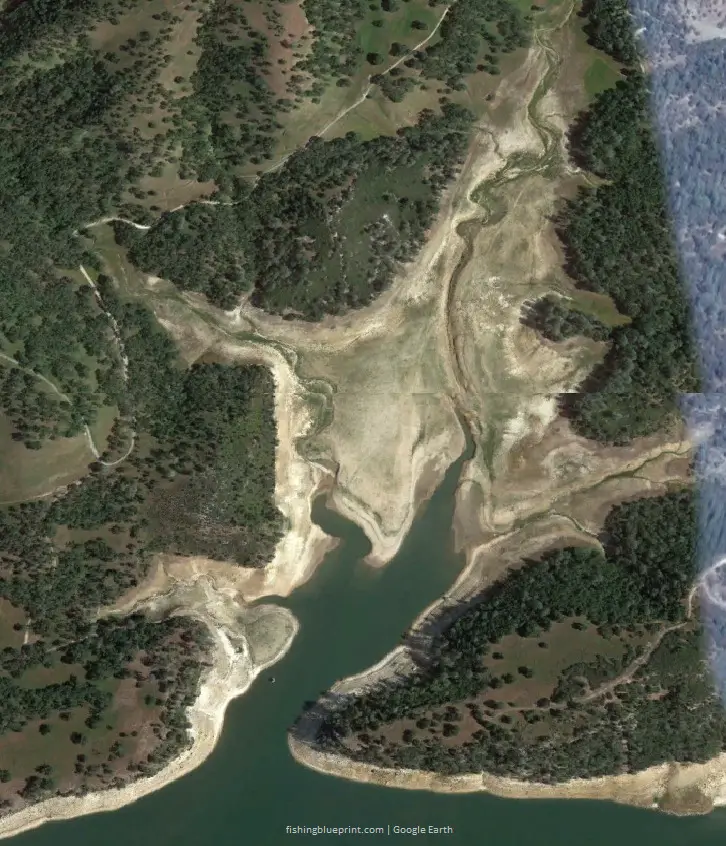
Above is a screenshot of Camanche Lake in California at low pool. Looking closely you can see the creek channel ledges winding through the arm.
Step 2: Find the Best Section of the Ledge So You Can Catch a Fish
As was mentioned briefly before, I consider ledges “highways”. My definition of a bass highway is anywhere in the lake that assists the bass to travel from spot to spot unimpeded is referred to as highways. Other highways can be large secondary creek channels, smaller drainage ditches that drain into a cove, and many, many more.
From my experience bass will only stay on a particular spot on a highway if it provides them with a good opportunity to hunt… otherwise they would go hungry and move somewhere else.
Think about it… if you go out to a restaurant and the restaurant runs out of food would you just sit there and wait? No, you would not. You would get up and go somewhere else. A bass does that same thing.
So what does a bass need in order to eat? A food source and an ambush location (or a hunting area).
That brings us to our next question? What does a bass consider a good ambush location?
Primary ambush locations are spots where bass can easily hunt for food and feel safe at the same time. They can be in form of a hump, ridges, rock pile, brush pile, road bed and many, many more.
So what does this have to do with ledges?
So when you get to the lake you must ask yourself, what ledges have the most ambush locations closest to it? Because those spots tend to hold more fish, and therefore increase your chances of catching one of these fish.
Then all you need to do is then scan these intersections and find those mega-schools of bass. Because when you do, you can jaw-jack them over, and over, and over.
Step 3: Identify the Ledge With Your Fish Finder/Sonar and Scan It
Now that you are on the water it’s time to find the ledge.
Finding a ledge on a fish finder is easy to do. This equipment can check the depth of water in a certain part of your lake as you drive your boat over the lake.
When you see a flat area fall to a deeper area, this is where a ledge will be located. It will look like a “V” between two flat parts of the lake or river on your electronics.
Red areas shown on your fish finder show flat areas with no or little change of depth within them.
When you find a ledge, examine it to look for bass suspended above the ledge, or on the top or sides of the ledge. Lastly, see if there are any bass at the lake bottom where the ledge ends.
Bass will appear as arcs with spaces between each one on a fish finder. They are usually in a horizontal line and do not pile up more than two or three fish above another one.
Finding Active vs. Inactive Fish
When scanning a ledge you want to see the bass on top of the ledge. This signifies the bass are actively feeding. These fish are extremely catchable anytime they are relating directly on top of ledge, best of all you can typically catch them using an assortment of lures.
Look at the images below. This is a downward scan image I recreated to show you what bass look like when they’re relating on top of the ledge.
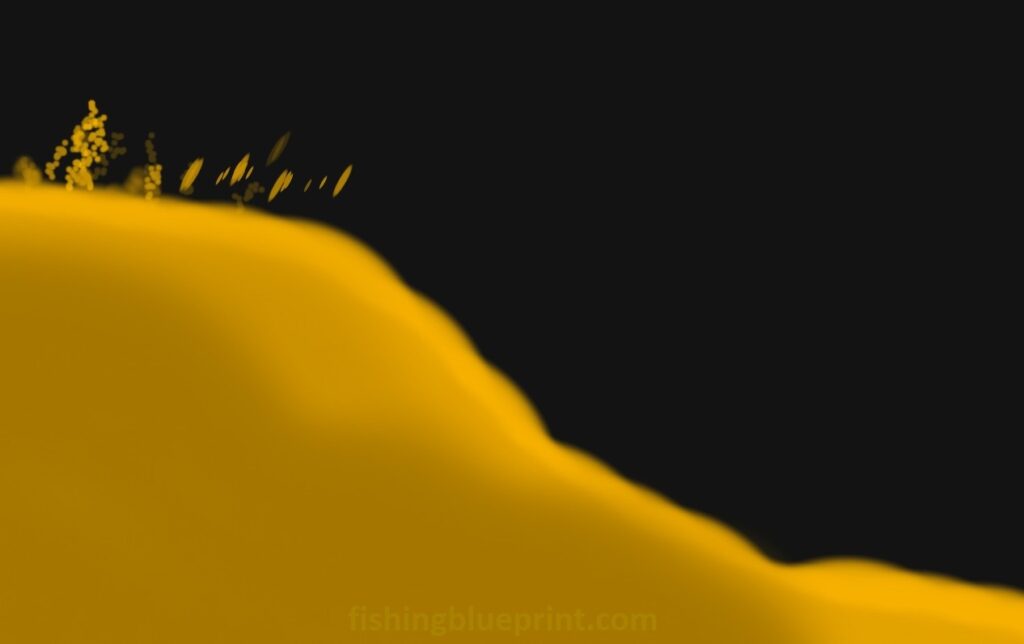
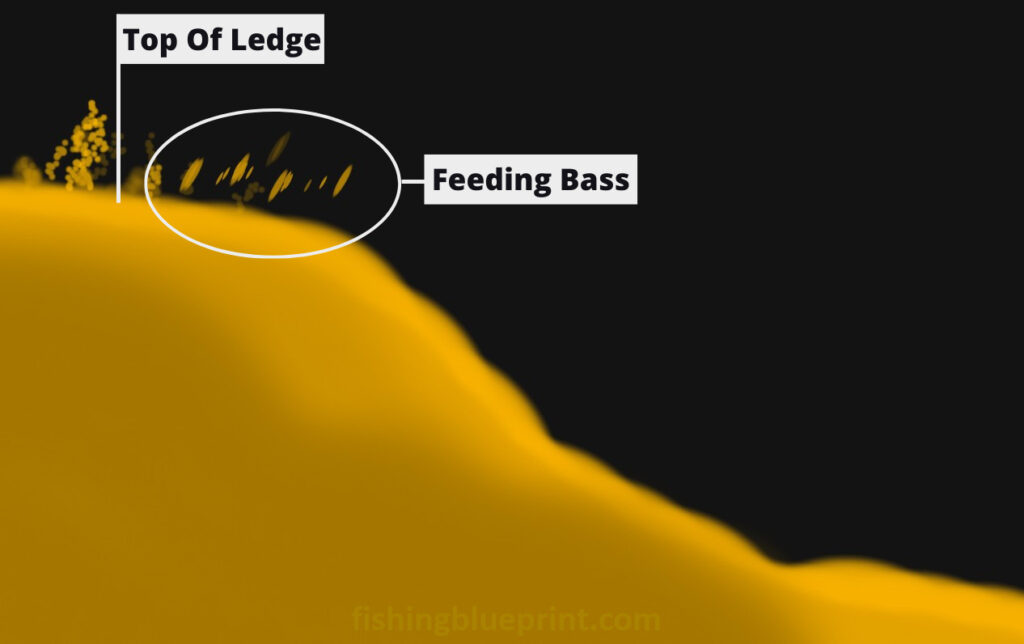
The bass will suspend above the deeper water, such as a creek channel or major river channel, when they are not actively feeding. As an illustration in the picture below, they won’t be placed on top of the ledge, but over deeper water instead.
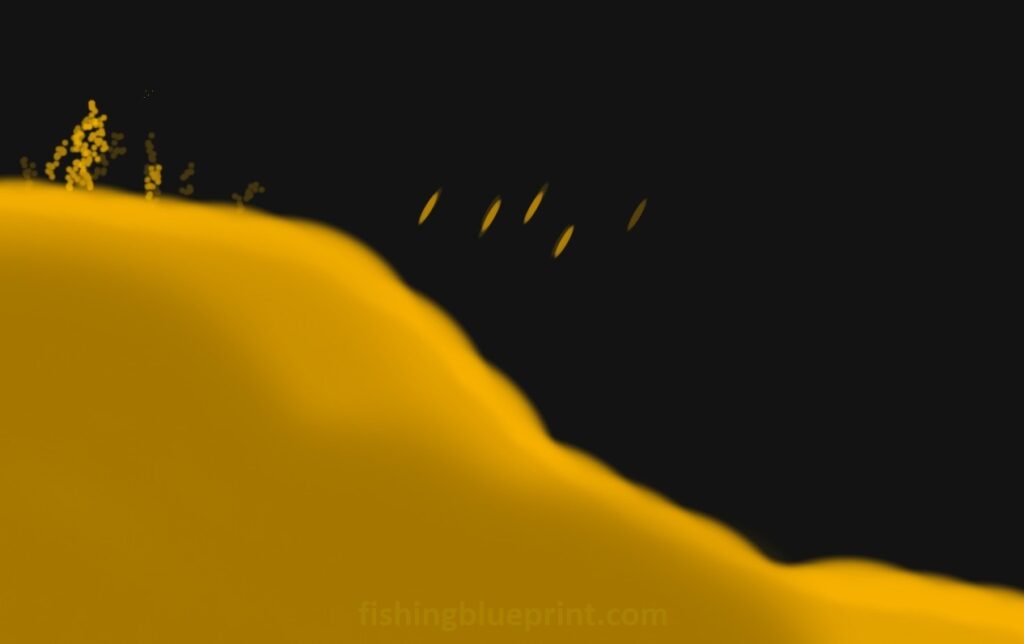
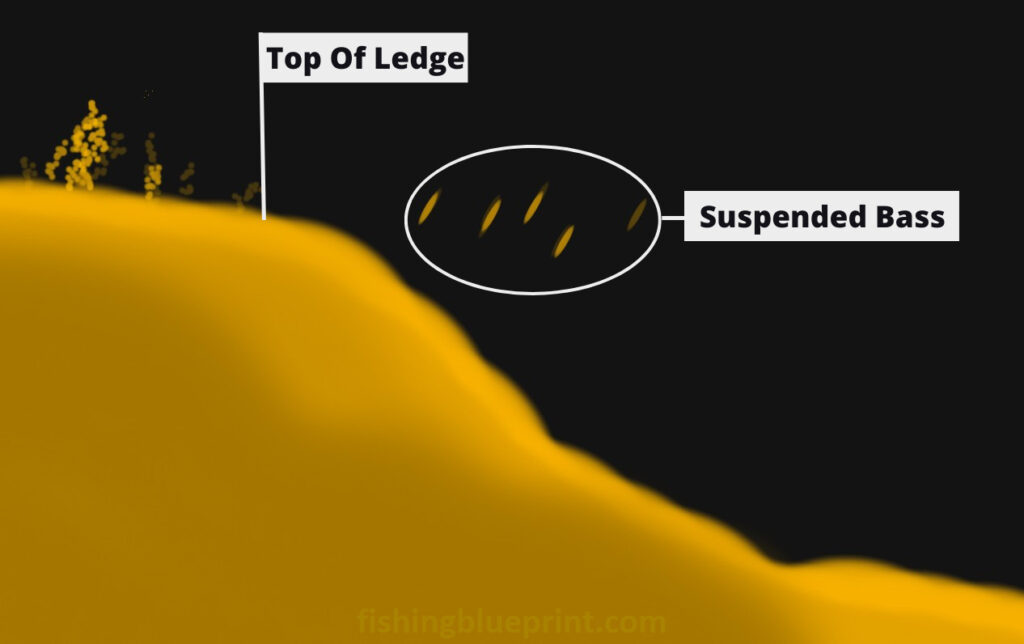
Step 4: Approaching the Ledge
If possible and when you’re fishing ledges it’s best practice to position your boat or kayak in deep water and cast up into shallow water. Furthermore, most anglers position themselves 30-50 feet back away from the ledge.
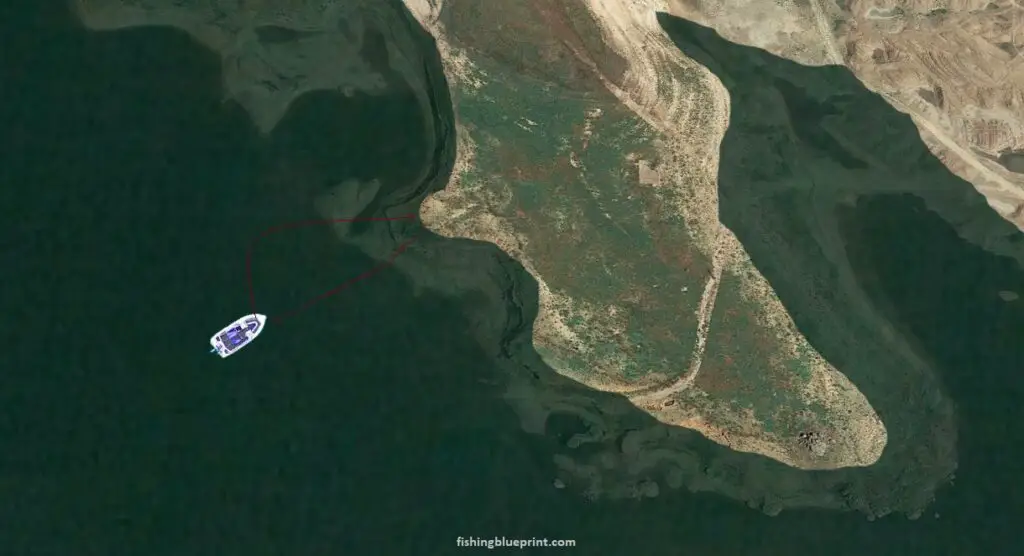
Step 5: Best Basic Presentation/Retrieval Techniques for Ledge Fishing for Bass
Many anglers know that bass fishing ledges require different techniques that depend on many factors such as:
- The depth of the water
- The season
- The wind
- The water clarity – is the water clear or muddy?
- The sky conditions – is it sunny or cloudy?
When you pull up on a school of bass that are on top of the ledge (again, this signifies they’re actively feeding) your first presentation should be with a reaction bait, something that can be fished fast.
A reaction bait needs to be fished aggressively in order to fire up the school and trigger a feeding frenzy.
As the bite starts to slow, changing the color of the bait, or switching to another bait altogether helps to get the feeding frenzy going.
Once the bite really starts to slow, it’s recommended to switch to a slower moving bait. It should pick up a few more bites.
Some anglers say that moving the bait too fast or unevenly can scare off the bass.
If you lose a fish in a school, often the rest of the fish in the school will not bite. Move to another ledge with bass if you do not hook onto any fish after a few throws.
Fishing success is a matter of outsmarting the bass. If one method is not working for you, try another technique that is based on the environment and area you are fishing.
Step 6: Throwing the Right Baits
Using the right bait can make or break your fishing trip. After years of fishing ledges and learning from some of the best ledge anglers out there we developed and organized all the best ledge fishing baits into one easy to follow system… and we still use it to this day!
First, the reaction baits we trust are going to be deep-diving crankbaits, flutter spoons, hair jigs, or big soft plastic swimbaits.
Once the feeding frenzy starts to slow, pick the rest of them off with football jigs or big 10+ inch worms.
You may want to try other slower fishing methods of presentation such as the Carolina rig, Neko rig, shaky head, wacky rig, or drop shot when fishing lake bottoms – especially if you excel in that technique.
Fast fishing is usually ideal because it keeps the fish interested and they may become aggressive enough to bite your bait.
But how do you catch bass that are suspended or inactive?
Well that can be a little more tricky…
I would suggest first throwing a big soft plastic swimbait. A simple cast and retrieve, keeping it just a foot or two really close to the bottom. And as the swimbait clears the lip of the ledge it’s going to swim right through the school of inactive bass that can trigger a bite.
Another bait to entice inactive bass into biting is a hair jig. While it does require a little more still to fish a hair jig, it does catch a variety of bass bass, not just largemouth bass.
I know this seems a little short, but I’ve devoted a full (no B.S.) report for you that goes over the best baits for ledge fishing for bass – Click HERE to get all the juicy details… now!
Step 7: Making the Perfect Cast To Offshore Structure - Every time!
Here is another method of making the ultimate cast for fishing offshore structures like ledges that I picked up from Justin at Fish The Moment.
So when you get to a spot and you catch your first fish, the first thing to do, is to search for a line-up on the bank once you’ve hooked a fish at an offshore structure (in this case it’s a ledge). Look for anything fairly apparent and big, like a really huge tree, a big home, boat docks, or something similar, anything with which to align your cast.
Then quickly, either use your GPS to create a waypoint where the nose of your boat is, or place a marker buoy exactly where you were standing when you caught the fish.
Be careful, unless you have a spot-lock on your trolling motor you may need to adjust your spot marker because often you’ll drift off the spot one you caught the fish.
Now you just created an ideal casting lane, because you now have two points to line up, which will make it easier for you the next time you target that specific spot!
Next, put the nose of your boat back on that waypoint (or right up next to that marker buoy) once you’re ready to make your next cast.
Finally, locate the line-up spot on the bank and cast right at that point.

My Final Private Notes...
With all of that said, I’ve fished a lot of ledges, and they can be a pretty darn good way to catch a TON of bass really fast.
At first I thought it was tough to initially get comfortable with ledge fishing, but once I got out on the water and really started to use the free 7-step formula I created, I quickly see saw my catch ratio explode!
So if you want to be successful, just remember the 7-steps to ledge fishing—find the ledge on the map first, choose the correct spots on the ledge, identify the spot on your sonar and check for fish, cast your lures from deep water into shallow water, have all types of lures at the ready, choose only the best performing lures that are known to catch bass on ledges.
This 7-step system simplifies the process when compared trying to wing it by yourself alone, and provides proven results that you integrate into fishing other offshore structures.
One last thing to keep in mind is that bass will move from spot to spot frequently on ledges. And even if the spot looks like it has all the right features, sometimes when you pull up and scan it it’s completely devoid of fish. Don’t worry about it, just move on to your next spot. Chances are your research and preparation are correct, but sometimes the bass are just not there—just come back to it later.
That’s it for now, take care and tight lines!
Want To Learn Where To Catch More Bass? Checkout These Articles...
- Bass Fishing CREEKS The Easy Way (In Less Than 10 Minutes)
- Warning: Bass Fishing HEAVY GRASS? [15+ Mistakes To Avoid]
- Bass Fishing POINTS in 5 Quick & EASY Steps!
- Complete 5-Step DOCK Fishing Formula
- Bass Fishing LAYDOWNS [Complete Guide + Pictures]
- Little Known Pattern for Fishing TREES for Bass.. Now and Forever
- Complete Formula For BASS FISHING ROCKY BANKS & RIPRAP
- The 5 TRUTHS about Bass Fishing BRIDGES and Avoid Wasting Time On Techniques That Don’t Work!
- Bass Fishing BRUSH PILES To Catch The Most Bass In Minimum Time!
- The 7-step Secret Formula for Bass Fishing LEDGES – Even a Complete Fishing Noob Can Use and Be 100 Times More Potent Than the Best B.A.S.S. Professional!
- The Single Best Guide to Fishing SHELL BEDS… and… Do It Fast!
- 5 Basic Elements Of Fishing HUMPS AND RIDGES No One is Talking About!
- 5 Crucial (and Unusual) Tactics You Must Do When Bass Fishing ROADBEDS!
- Top 25 Summer BANK Fishing Tips (Never Get Skunked Again)
- [EXPERT REVEALS] Bass Fishing In MUDDY WATER Secrets – 27 Tips & Mistakes To Avoid Today!
- 31 Best Tips for Bass Fishing At NIGHT (Complete Guide)
Checkout These Other Summer Fishing Articles...
- Complete 5-Step Formula For BASS FISHING DOCKS
- The 7-step Secret Formula for BASS FISHING LEDGES – Even a Complete Fishing Noob Can Use and Be 100 Times More Potent Than the Best B.A.S.S. Professional!
- Top 25 Summer Bank Fishing Tips (Never Get Skunked Again)
- Bass Fishing In Heavy Grass? [17+ Mistakes To Avoid]
- 7 Top Secret Weedless Bass Lures for Flipping into Heavy Grass -Exposed!
- How To Fish A Crankbait [TOP 10 Essential Secrets To Catching Bass With A Crankbait]
- 15 Best Deep Diving Crankbaits [2023 Buyers Guide – Which to Buy & Avoid]
- Fish a Flutter Spoon The RIGHT way... like the Pros... And Do It TODAY!
- NEW and truly "no brainer" (yet usually overlooked) way to MASTER SOFT PLASTIC PADDLE TAIL SWIMBAITS and increase the amount of bass you catch 100% or more... automatically!
- Top 5 questions and challenges every about hair jig fishing... AND how to overcome common problems most anglers encounter (and then prematurely quit).
- Top 10 Best Jigs For Bass Fishing [Insiders Only]
- Avoid this ONE Texas rig fishing NIGHTMARE - And increase your Texas rig fishing expertise FAST!
- 31 Best Tips for Bass Fishing At NIGHT (Complete Guide)
- 2023 Buyers Guide Best GREEN FISHING LIGHT [LED FISHING LIGHTS Reviews & Tips]
- Dock Lights For Night Fishing [Best Products, Secrets, & Tips]
Other Bass Fishing Articles Just For You...
Selecting Early Summer Bass Fishing Lures [Avoid 5 Common Mistakes]
A Complete Buyer’s Blueprint On The Best Early Summer Bass Lures On The Market Today! When it comes to bass fishing, choosing the right lure
Early Summer Bass Fishing [Avoid These 3 Sneaky Lies]
Learn these closely guarded secrets early summer bass fishing … and… dramatically boost your advantage over other anglers! Late spring to early summer bass fishing
Fear The Finesse? 7 Ned Rig Fishing Secrets Exposed!
Conquer the Fear of Finesse… and… Unlock the Potential Ned Rig Fishing – TODAY! Fellow Angler… Like most of you I’m pretty set in my
Fishing Spawning Bass [18+ Lures & Gear]
Get Ready For The Spawn Now When bed fishing, stealth is of the biggest essential tip. Instead of racing forward with a trolling motor, anglers
[2024 Editors Choice] Picking The Best Bass Fishing LINE For ANY Budget
What is the best bass fishing line? | What is a good fishing line for bass? The best type of bass fishing line is based
Drift Sock Basics – What It Is A Drift Sock & How To Use It [2024 Quick Start Guide]
What Does A Drift Sock Do? | Why Use A Drift Sock? photo cred: WLUK We’ve ALL been there… you work your butt off the
